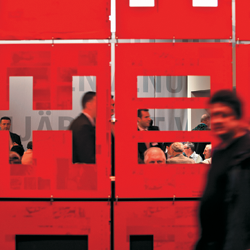 xhibit designer and eco pioneer Tom Bowman has seen a drastic change of climate when it comes to the Greening of the exhibition industry. The president of Signal Hill, CA-based Bowman Design Group, he has helped a once-fringe movement become mainstream through his work with leading scientists creating experiential exhibits for the National Academy of Science's Marian Koshland Museum and the Scripps Institution of Oceanography's Birch Aquarium. A speaker on climate change and sustainable practices for trade show industry associations and professional conferences such as EXHIBITOR Show and the Exhibit Designers and Producers Association (EDPA), Bowman now brings his eco expertise to readers in EXHIBITOR's new online-only column, Ask Mr. Green. We caught up with him to talk about the emerging role the Green movement is playing in the exhibition industry and the various ways exhibit managers can take their programs in a more eco-friendly direction. To read his first installment of Ask Mr. Green - which addresses how to write a Green RFP - visit www.GreenExhibiting.com.
xhibit designer and eco pioneer Tom Bowman has seen a drastic change of climate when it comes to the Greening of the exhibition industry. The president of Signal Hill, CA-based Bowman Design Group, he has helped a once-fringe movement become mainstream through his work with leading scientists creating experiential exhibits for the National Academy of Science's Marian Koshland Museum and the Scripps Institution of Oceanography's Birch Aquarium. A speaker on climate change and sustainable practices for trade show industry associations and professional conferences such as EXHIBITOR Show and the Exhibit Designers and Producers Association (EDPA), Bowman now brings his eco expertise to readers in EXHIBITOR's new online-only column, Ask Mr. Green. We caught up with him to talk about the emerging role the Green movement is playing in the exhibition industry and the various ways exhibit managers can take their programs in a more eco-friendly direction. To read his first installment of Ask Mr. Green - which addresses how to write a Green RFP - visit www.GreenExhibiting.com.
Exhibitor Magazine: What is the biggest misconception exhibitors have about Greening their programs?
Tom Bowman: That going Green is too difficult and automatically means spending a lot more money. Fortunately, information from the most reliable sources we have can boil it down to specific, cost-saving actions.
Some Greener materials, such as Forest Stewardship Council-certified lumber, do cost a little more. But looking at just one factor in isolation can be misleading. Let's say you build an exhibit with sustainable FSC-certified wood. The wood might cost you an extra 40 to 60 percent. But lumber is just one material in the exhibit, so the overall exhibit might only cost a few percent points more to build, which probably isn't very much. And booth construction and refurb represent 25 percent of the budget for a typical trade show. From this perspective, the added cost is not large.
Now, suppose you add the Greenest tactic of all - conserving - by keeping that exhibit a few years longer than you had previously planned, refreshing its look along the way. Your upfront investment was slightly higher, but over the long haul you will have netted a huge savings by reusing the exhibit longer than you planned.
EM: Many exhibitors are using bamboo in their booths. But is bamboo really Greener than other woods?
TB: That's a tough question, but again there are some simple guidelines. On one hand, bamboo is a rapidly renewable resource. The plant matures every three to five years while many hardwood trees - including the birch trees used to make most exhibit plywood - take 40 to 50. Growing plants and trees remove carbon dioxide from the air, so rapidly growing bamboo forests help fight global warming.
On the other hand, there's a definite downside. Bamboo is a decorative material, so it costs more than the hardwoods used to build exhibit walls and cabinets - as much as 500 percent more than domestic FSC-certified birch ply. And it's manufactured overseas: About 80 percent of the world's bamboo supply is located in China, India, and Myanmar. In China, for instance, pollution controls are lax. Some old-growth forests have been cleared to make way for bamboo plantations. Some plantations use fertilizers and pesticides to increase yields, and some bamboo is turned into plywood using high levels of formaldehyde. Finally, bamboo is shipped to America on ships that burn fossil fuels and emit greenhouse gases and other pollutants. How can you know where your bamboo comes from and how it is produced?
Last April, San Francisco-based Smith & Fong Co. announced the first FSC-certified bamboo plywood. This means it comes from a sustainably managed forest in China, where it's grown without using any irrigation, pesticides, or fertilizers. The bamboo is harvested by hand and processed at a certified plant. It's unclear yet what kinds of adhesives are used in the manufacturing process, but now with FSC certification you can buy bamboo without being bamboozled.
EM: One reason companies are choosing Green exhibit options is to appeal to consumers. So once they've taken steps to go Greener, how can exhibitors promote those eco-friendly efforts?
TB: To date, there is no industry-wide certification for what constitutes a Green exhibit, so you can't exactly slap the Green version of the Good Housekeeping Seal of Approval on your booth and call it a day. But let's assume you're building or refurbishing a custom booth and you want to demonstrate that you've made it Greener. Consider forming Green initiative partnerships with groups that offer certifications for certain types of materials - such as recycled carpets or FSC hardwoods - or perhaps companies from which you purchased carbon offsets. Then promote your partnerships with such organizations by putting their logos in highly visible spots in your booth. These markers from independent third parties will show that your company is committed to change and isn't Greenwashing.
You might also compile the changes you've made with regard to the environment and report them to potential customers for an upcoming show via an e-mail news release that lists your efforts, and then puts them in the context of your company's Green goals, so they don't look gratuitous.
For the show, staff could be trained to point out the same eco-friendly components, such as your FSC-certified lumber, the carbon-neutral carpet (or other flooring) that is high in recycled content, the non-VOC paints and adhesives, the plastic laminate from a domestic supplier, or the LED lighting instead of halogens. You could also advertise your efforts on brochures you make available on USB drives or through e-mail-on-demand stations in your booth.
EM: But what if you're simply reusing a booth you already own?
TB: Using the booth you already own might be your Greenest option at the moment because you don't have to consume any new resources to build a new one. Sometimes not doing anything with your booth can be the Greenest move of all.
EM: What kinds of Green options are available for exhibit transportation? How effective are they?
TB: Unfortunately, trucking just isn't very Green. Even newer trucks emit more than three times as much CO² per mile than the average car.
Some exhibitors are turning to companies whose trucks run on biodiesel fuel. A year ago, biodiesel looked promising. Made from vegetable oils such as soy - animal fats from meat processing can also be used - the nontoxic and biodegradable fuel emits just as much CO² from a truck's smokestack as regular diesel. But soybean plants absorb CO² from the air as they grow, and the net effect is a huge reduction in life cycle emissions when compared to regular diesel. Today, however, biodiesel doesn't look so promising. Two 2008 studies published in the journal Science showed that when crop irrigation, fossil-fuel-based fertilizers and pesticides, and conversion of land to fuel crops are factored into the equation, biodiesel is just about even with regular diesel in life cycle CO² emissions. Corn-based ethanol for cars is turning out to be much worse than gasoline. And the rush to grow these crops for fuel instead of food is contributing to global deforestation, higher food prices, and the global food shortage.
What's an exhibitor to do? First, do everything possible to avoid last-minute air shipments. Of all the transportation options available, flying has the largest carbon footprint. The impact of carbon emissions at cruising altitudes is 2.7 times higher than it would be on the ground because jet contrails help form clouds that trap heat.
Second, pad wrap your shipments. Bulky crates cost money - typically more than $1,000 each - and they consume a lot of extra space on trucks. Pad wrapping means more freight per truck and fewer trucks on the road.
 |
 We've been told for years that conservation means sacrifice, but that just isn't true anymore. We need to redefine conservation in terms of ROI by running an exhibit program where lower costs and a smaller environmental footprint can amount to the same thing. We've been told for years that conservation means sacrifice, but that just isn't true anymore. We need to redefine conservation in terms of ROI by running an exhibit program where lower costs and a smaller environmental footprint can amount to the same thing. |
 |
Third, look for shipping companies that take action to reduce the carbon footprint of shipping your freight, such as EA Logistics and Con-Way Inc. EA Logistics compensates for the greenhouse gases it emits while shipping your booth by purchasing carbon offsets from Carbonfund.org. Con-Way Inc. limits how fast its trucks can run to 62 miles per hour, increasing fuel efficiency and reducing carbon emissions. I also suggest choosing shipping companies that have modern fleets, since older trucks are about 20 percent less fuel efficient than new ones.
Another option is to bypass shipping entirely by renting as much as you can locally, including exhibit properties, furniture, audiovisual gear, lighting, etc. Instead of shipping product literature, put information on USB drives and hand them out, or e-mail e-brochures to attendees from the show floor. That way you're decreasing your shipments, reducing paper waste, and avoiding printing costs to boot.
EM: How can I find out if my exhibit house is Green?
TB: Ask your exhibit house about two things: specific materials, and how it's reducing its carbon footprint. Does it use FSC-certified lumber? Does it use non-VOC adhesives and paints to cut down on air pollution? Does it use carbon-neutral, recycled carpet and other eco-friendly flooring materials? Does it use LED lighting instead of halogens? Does it recycle scraps and old exhibits at the end of their useful lives? Does it donate usable materials to local charities? Does it measure its own carbon footprint? Asking these questions is a good test to see whether your exhibit house is just paying lip service to going Greener, or if it will really be able to help you Green your exhibit-marketing program. If it seems to come up short, you might need to look elsewhere to achieve your company's Green goals.
EM: What's the easiest way for exhibitors to start going Green?
TB: One of the biggest misconceptions is that sustainability is all about new products and booths. New, Greener products and services are very important, sure, but so is conservation. In fact, conservation - reducing waste in energy, materials, and unnecessary travel - is the cheapest way to start moving toward Greener pastures. And scientists also point out that conservation is the quickest way to reduce your carbon emissions.
We've been told for years that conservation means sacrifice, but that just isn't true anymore. Conservation just means saving on things none of us enjoy paying for anyway. We need to redefine conservation in terms of ROI by running an exhibit program where lower costs and a smaller environmental footprint can amount to the same thing. Going Greener shouldn't be viewed as an add-on. It's core business. It's good business.
EM: What can readers expect from your new column, Ask Mr. Green?
TB: The online column will field readers' questions about how to make their exhibit programs more sustainable. I'll give practical advice and suggestions for making choices in everything exhibit managers do, from writing RFPs to selecting materials to changing the way we organize budgets. Every installment will offer tangible, hands-on solutions that will help readers now, while explaining the larger context and making the business case for their bosses. The column will become a one-stop shop for organizing a Greener - and better - exhibit program.
For example, the first installment of the column explains how to write a Green RFP and what to look for in the responses. Future installments will feature Greener materials and catering choices, and information on how to repurpose your exhibits to get maximum use out of your custom properties. The column will also explore some of the bigger questions you'll face, such as how to properly define Green, what the most important Green issues might be, and what we can measure to cut through all the so called Greenwashing and get real, objective results. e
|










